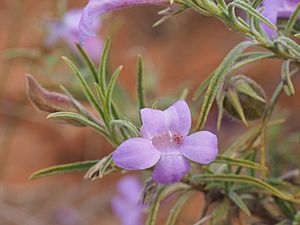Charleville turkey bush facts for kids
Quick facts for kids Charleville turkey bush |
|
|---|---|
 |
|
| Eremophila gilesii gilesii leaves and flowers | |
| Scientific classification | |
| Genus: |
Eremophila (plant)
|
| Species: |
gilesii
|
Eremophila gilesii, also known as the Charleville turkey bush, green turkey bush, desert fuchsia, or Giles emu bush, is a type of flowering plant. It belongs to the figwort family, called Scrophulariaceae. This plant is endemic to Australia, meaning it is only found there.
It usually grows as a low, spreading shrub. Its flowers are often pinkish-lilac to purple. You can find this plant across the Northern Territory and in all Australian mainland states except Victoria. In some areas of Queensland, it can spread quickly on farms. However, Aboriginal people often use it as a traditional medicine.
Contents
What Does the Charleville Turkey Bush Look Like?
The Eremophila gilesii is usually a low, spreading shrub. Sometimes it grows flat on the ground, or it can stand upright. It typically reaches a height of about 0.15 and 0.8 m (0.5 and 3 ft). Its branches and leaves feel sticky because they have a natural resin on them.
The leaves grow one after another along the stems. They are 12–91 mm (0.5–4 in) long and 0.5–5.6 mm (0.02–0.2 in) wide. Their shape is long and narrow, or like a spearhead. They are covered with tiny glandular hairs. Sometimes, the edges of the leaves have small teeth.
The flowers usually grow one by one where a leaf meets the stem. They sit on a sticky, S-shaped stalk that is 6.5–32 mm (0.3–1 in) long. Each flower has five green sepals, which are like small leaves protecting the bud. These sepals are 5.5–16 mm (0.2–0.6 in) long and covered in glandular hairs.
The petals are 16.5–40 mm (0.6–2 in) long and join together at the bottom to form a tube. The outside of this tube is white to lilac, and the inside is white with purple spots. The outside of the tube and the petal tips are hairy. However, the inside of the petal tips is smooth, and the inside of the tube is woolly. There are four stamens (the parts that produce pollen) hidden inside the petal tube.
This plant flowers from March to November. After flowering, it produces dry, woody, oval-shaped fruits. These fruits are hairy and measure 6.5–12.5 mm (0.3–0.5 in) long.

How Was it Named?
The Charleville turkey bush was first officially described in 1873. This was done by a scientist named Ferdinand von Mueller. He published his description in a book called Fragmenta phytographiae Australiae.
The plant's scientific name, gilesii, honors Ernest Giles. He was the person who first collected the specific plant sample used to describe the species. This sample is called the type specimen.
There are two slightly different types, or subspecies, of Eremophila gilesii:
- Eremophila gilesii subsp. gilesii: This type has flower stalks that are clearly flat. Its leaves are long and narrow. This subspecies is found in more places across Australia.
- Eremophila gilesii subsp. variabilis: This type has flower stalks that are only a little bit flat at the bottom. Its leaves are oval or spear-shaped. This subspecies is only found in Western Australia.
Where Does the Charleville Turkey Bush Grow?
The Eremophila gilesii subsp. gilesii grows in several parts of Australia. In New South Wales, you can find it in the Wanaaring and Enngonia areas in the northwest. It is also common in the western half of South Australia. You can see it in the southern half of the Northern Territory and across a central band of Western Australia. This plant prefers to grow in sand or loam soils on flat plains and low hills.
The subspecies variabilis is found only in Western Australia. It grows in sandy, clay, or laterite soils. You can spot it on plains or in rocky areas within regions like the Gascoyne and the Great Victoria Desert.
How Does it Affect its Environment?
The Charleville turkey bush can grow back very quickly after areas of mulga trees are cleared. Because of this, it is sometimes seen as a plant that can cause problems on farms in places like south-west Queensland. It produces many seeds and can form thick patches with thousands of shrubs in one area. This can make it hard for other plants, like pasture grasses for animals, to grow.
Farmers have tried different ways to manage this plant. They have used methods like allowing many animals to graze after heavy rain. More recent studies show that methods like ploughing might not reduce the number of plants, but they can make the plants smaller. This makes it easier for animals to move around.
Is it Protected?
Both subspecies of Eremophila gilesii are considered "not threatened." This classification is given by the Western Australian Government's Department of Parks and Wildlife. This means they are not currently at risk of disappearing.
How is This Plant Used?
Traditional Indigenous Uses
Aboriginal people use the Charleville turkey bush in several ways. They make special drinks, called decoctions and infusions, from the plant. These are used to help treat various health issues, such as headaches, chest pains, sores, and colds.
Growing in Gardens
This Eremophila plant is a good choice for most gardens. The type found in Queensland has larger grey leaves and flowers for a longer time than other types. All varieties have large, attractive blue to purple flowers that are easy to see.
You can grow this plant from cuttings. Another way is by grafting, which is often better if you want to grow it in heavier soils. Once mature, the plants can handle dry weather and frost. They also benefit from watering during long dry periods. Light pruning can help keep the plant in a nice shape.

